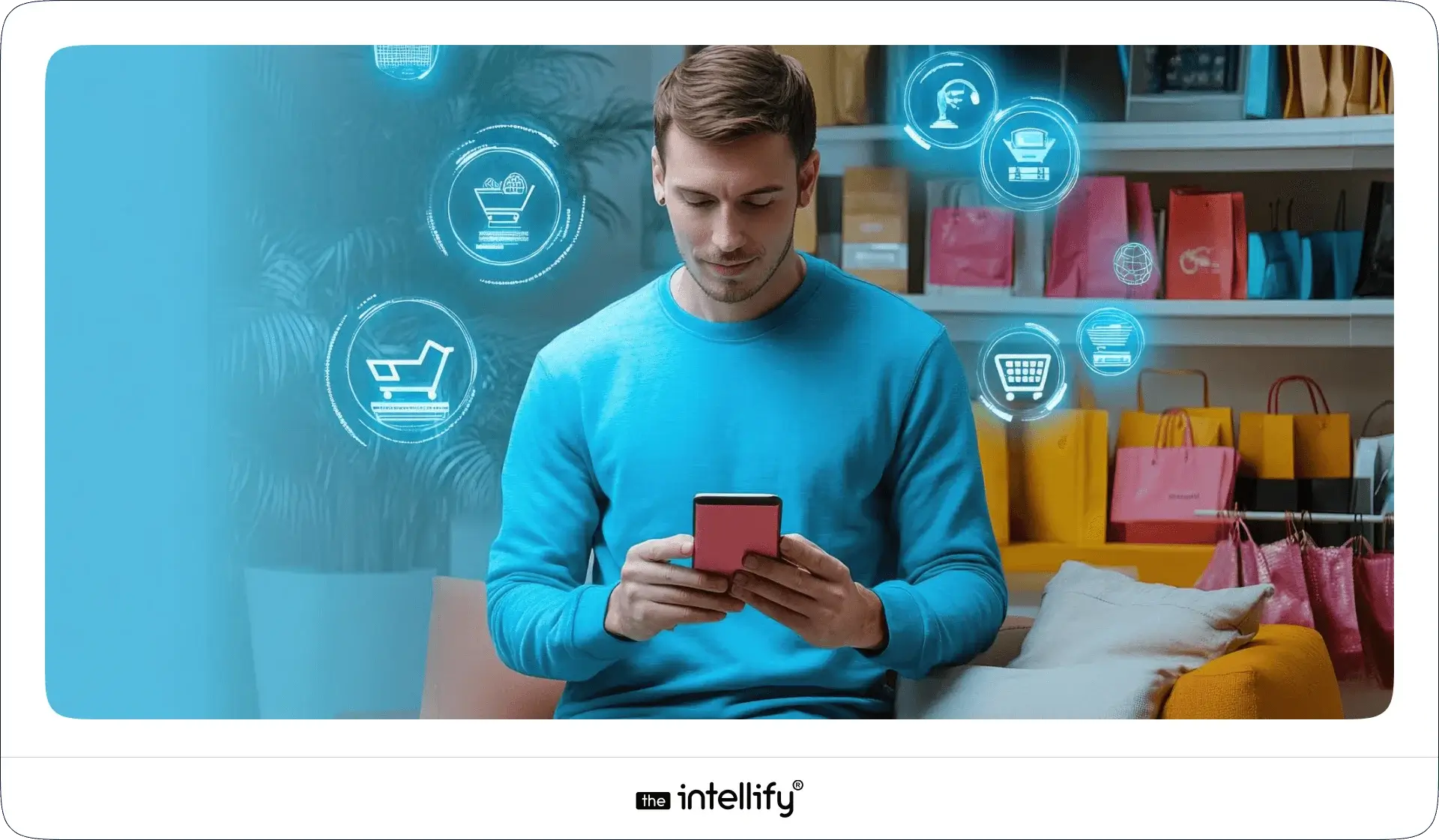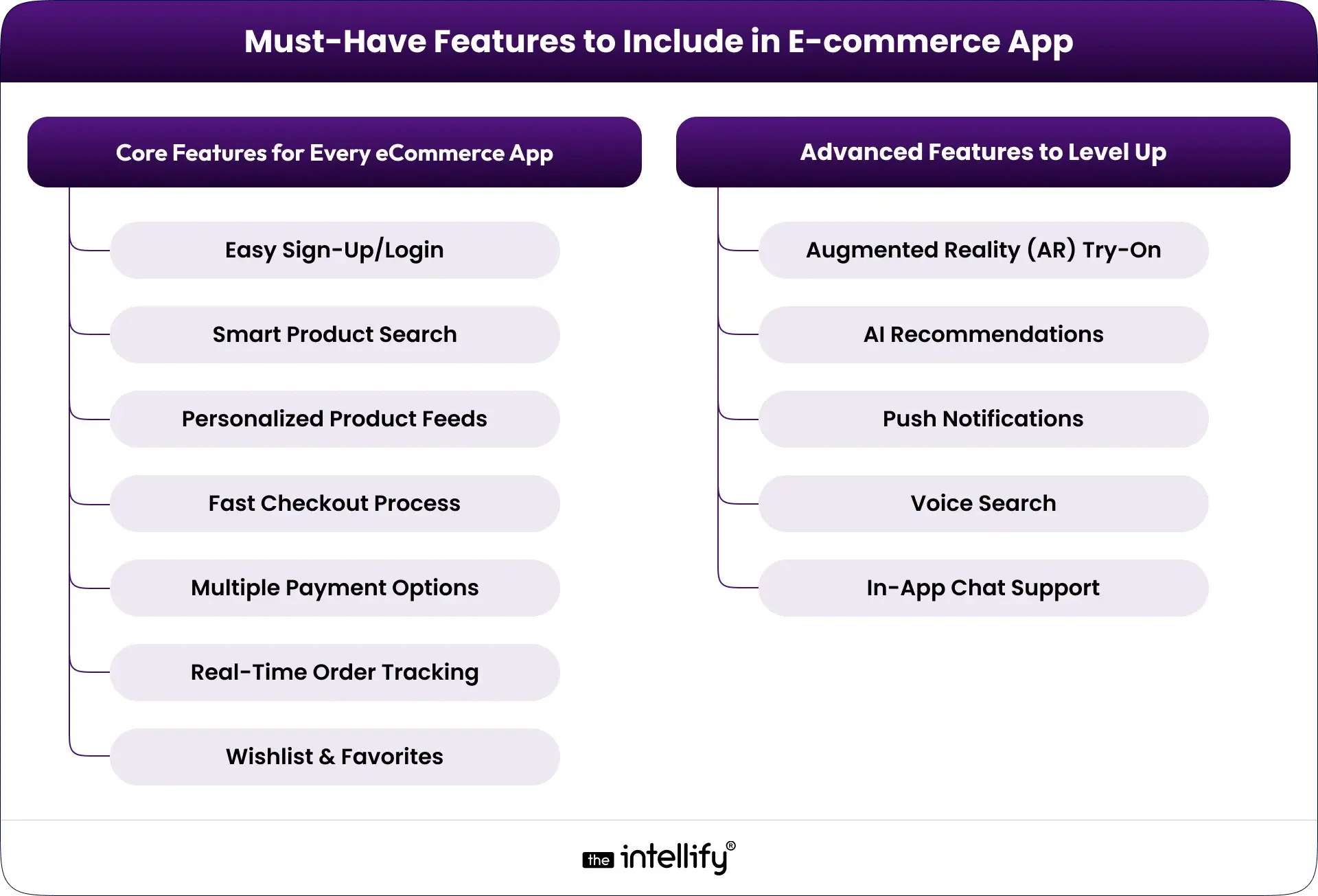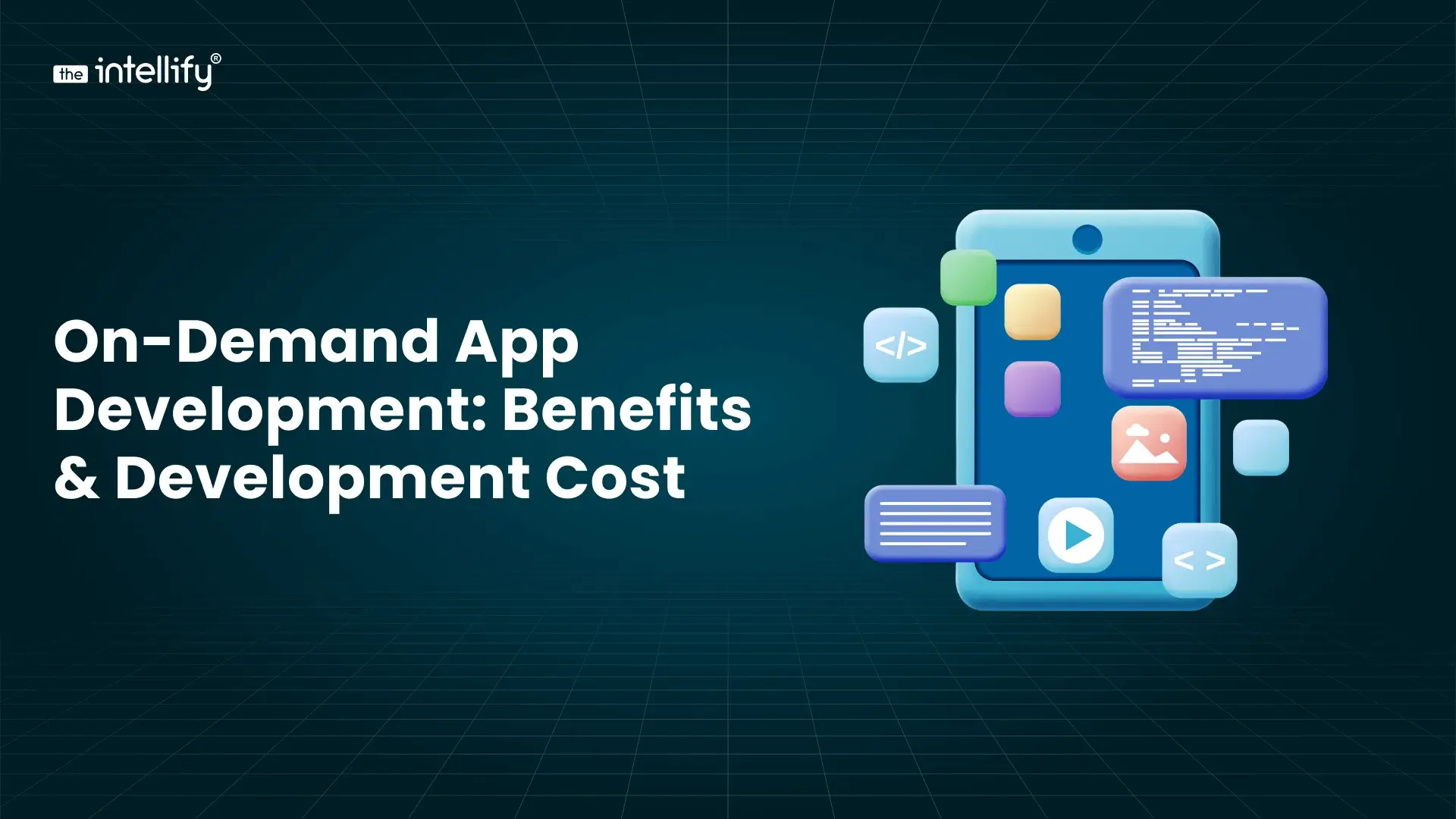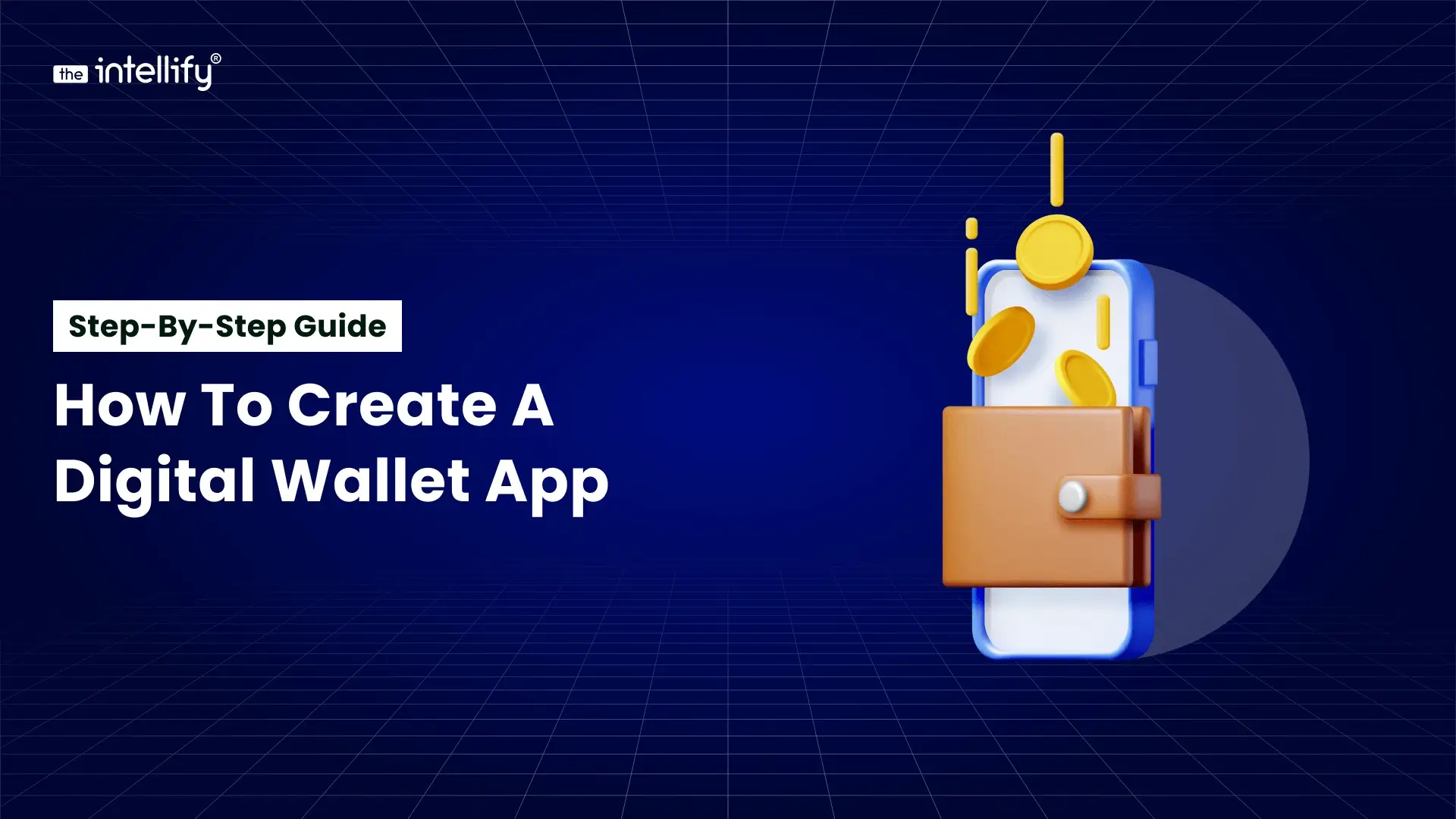How to Develop an eCommerce App: Guide for Brands & Retailers

By Shravan Rajpurohit
November 7, 2025

Summary:
Thinking about building an eCommerce app for your brand in 2025? This blog walks you through everything you need to know about eCommerce app development, from defining your business goals and choosing the right tech stack to designing a seamless shopping experience your customers will love. You’ll also learn about the must-have features, development process, estimated cost in the U.S., and smart marketing strategies to grow your app after launch. Whether you’re a startup or a retail brand ready to scale, this guide helps you plan, build, and launch a successful eCommerce app that drives sales and strengthens your digital presence.
The eCommerce App Boom You Can’t Afford to Ignore
Let’s be honest, people don’t “go shopping” anymore. They scroll, tap, swipe, and buy in seconds. From your favorite sneakers to that last-minute birthday gift, everything happens inside sleek, mobile eCommerce apps.
And here’s the kicker: over 70% of U.S. online sales now come from mobile devices (Statista, 2025). If your brand doesn’t have an app yet, you’re probably losing customers to someone who does.
This guide breaks down everything you need to know about how to develop an eCommerce app – the strategy, tech, cost, and design principles that actually make users want to come back.
Understanding Why You Need an eCommerce App in 2025

The best apps don’t start with “we need one too.”
They start with “why.”
Your “why” defines your entire app development direction.
- Are you trying to build customer loyalty?
- Do you want to personalize shopping experiences?
- Are you targeting Gen Z mobile shoppers or busy professionals?
Your goal will guide every decision, from which features you prioritize to how your app communicates your brand story.
Example: A skincare brand might focus its app around personalized routines and AR skin analysis, while a fashion label could build “try before you buy” features with virtual fitting rooms.
Must-Have Ecommerce App Features to Include in 2025

Here’s the deal: flashy features don’t make an app successful; useful ones do.
Core Features for Every eCommerce App
- Easy Sign-Up/Login: One-tap social or biometric logins, no friction.
- Smart Product Search: AI-powered suggestions, filters, and auto-complete save time.
- Personalized Product Feeds: People love it when your app “gets” them.
- Fast Checkout Process: Three steps max: cart, address, pay.
- Multiple Payment Options: Apple Pay, Google Pay, PayPal, cards, and even crypto.
- Real-Time Order Tracking: Transparency builds trust.
- Wishlist & Favorites: Keeps engagement high even when users aren’t ready to buy.
Advanced Features to Level Up
- Augmented Reality (AR) Try-On: Furniture, clothes, or virtual makeup try before you buy.
- AI Recommendations: Smarter upselling and cross-selling.
- Push Notifications: Send discounts, back-in-stock alerts, or birthday offers.
- Voice Search: For users who’d rather ask Siri than type.
- In-App Chat Support: Fast answers reduce abandoned carts.
Tip: Launch your MVP (Minimum Viable Product) first. Collect real feedback before investing in bells and whistles.
Choosing the Right Platform & Tech Stack for eCommerce App Development
Your platform = your user base. Choose wisely.
Native App Development
- Pros: Best performance, access to full device features.
- Cons: Higher cost (you’ll need two versions, iOS & Android).
Cross-Platform Development (React Native / Flutter)
- Pros: Build once, run anywhere; cost-efficient and fast.
- Cons: Slightly limited for ultra-high performance apps.
Progressive Web Apps (PWAs)
- Pros: Instant install, SEO-friendly, no App Store approvals.
- Cons: Limited offline capabilities compared to native.
Recommended Tech Stack:
- Frontend: React Native / Flutter
- Backend: Node.js, Python (Django), or Ruby on Rails
- Database: PostgreSQL, Firebase
- Cloud Hosting: AWS, Google Cloud, or Azure
At The Intellify, we use scalable, future-proof architectures so your app won’t crumble when your user base doubles overnight.
Designing an eCommerce App That Feels Effortless (UI/UX Tips That Convert)
People don’t remember every button, but they do remember how your app made them feel.
Key Design Principles
- Keep it Clean: White space is your friend. Avoid clutter.
- Visual Hierarchy: Highlight products and CTAs clearly.
- Faster Load = More Conversions: Each second of delay can drop sales by 7%.
- Micro-Interactions: Subtle animations make browsing feel alive.
- Consistency Across Devices: Seamless transitions from phone to tablet.
Case in Point: Target’s mobile app nails personalization with tailored deals and smooth navigation, one reason its app revenue crossed billions in 2024.
Design is emotion. Don’t just sell delight.
Step-by-Step E-commerce App Development Process

Developing an eCommerce app can feel like juggling tech, design, and deadlines but with a good plan, it’s totally manageable.
Here’s your roadmap:
1. Research & Strategy: Define your target audience, unique value, and competitor gaps.
2. Wireframing & UI/UX Design: Sketch layouts, user journeys, and a prototype for early feedback.
3. Development Phase: Frontend + backend development, API integration, database setup, and admin dashboard.
4. Testing: Functional testing, performance checks, and security audits.
5. App Launch: Submit to the App Store/Play Store, or go live with your PWA.
6. Maintenance & Scaling: Update features, monitor analytics, and keep optimizing post-launch.
Partnering with a professional e-commerce app development company like The Intellify ensures smoother sprints, transparent communication, and faster time-to-market.
E-commerce App Development Cost in the U.S. (2025 Estimates)
Let’s get into the dollars.
The cost of developing an e-commerce app depends on complexity, design, and platform.
| Type of eCommerce App | Estimated Cost Range | Timeframe |
|---|---|---|
| Basic MVP | $15,000 – $30,000 | 3-4 months |
| Mid-Level App | $35,000 – $60,000 | 4-6 months |
| Advanced App (AR/AI) | $70,000 – $150,000+ | 6-9 months |
Cost Tip: Outsourcing to a hybrid team (U.S. + offshore) can reduce cost by 30-40% while maintaining top quality.
Don’t forget maintenance! Post-launch support costs around 15-20% of total project value per year.
Marketing, Retention, and Monetization Strategies for eCommerce Apps
Building an app is half the battle – marketing keeps it alive.
Marketing That Works
- Pre-Launch Buzz: Teasers, early access, influencer sneak peeks.
- App Store Optimization (ASO): Keywords, screenshots, and ratings.
- Email Marketing: “Download the app for exclusive offers.”
- Paid Ads: Google UAC + Meta Ads targeted to mobile users.
Retention = Repeat Revenue
- Personalized notifications (“Hey, your favorite sneakers are 20% off!”)
- Loyalty programs that actually reward users
- AI-based recommendations that feel human
Monetization Models
- Direct Sales (D2C): Standard retail model.
- Subscription: Exclusive access or perks (think Prime).
- Commission-Based: For marketplace-style apps.
- In-App Ads: If done tastefully, can supplement revenue.
Pro Tip: Use push notifications wisely. Relevant + timely = engagement. Too many = uninstalls.
Common Challenges in E-Commerce App Development (and How to Fix Them)
| Challenge | Reality | Fix |
|---|---|---|
| High Cart Abandonment | 70% of users leave before checkout | Simplify checkout, add guest checkout |
| Low App Engagement | Poor UX or irrelevant content | Add gamification, personalization |
| Performance Lag | Heavy visuals, bad caching | Optimize media, enable lazy loading |
| Security Concerns | Data leaks scare users | Use end-to-end encryption, tokenized payments |
Extra Tip: Regularly update your app. Inactive apps lose visibility in App Store algorithms.
The Future of E-Commerce App Development in 2025 and Beyond

The e-commerce landscape isn’t slowing down, it’s evolving fast.
Here’s what’s shaping 2025 and beyond:
- AI Personalization: Apps that understand buying behavior in real-time.
- Voice Commerce: “Alexa, reorder my protein bars.”
- AR/VR Shopping: Try, place, or visualize before purchase.
- Sustainability & Ethical Shopping: More users value eco-conscious brands.
- Frictionless Payments: One-tap checkout with digital wallets.
If you’re planning your app, future-proof it. Build for where users will be, not just where they are.
Choosing the Right E-Commerce App Development Company
The right partner isn’t just a coder, they’re a strategist.
Look for an e-commerce app development company that:
- Has proven experience in eCommerce & retail app development
- Communicates clearly (no jargon, no surprises)
- Offers post-launch support
- Provides UX strategy, not just UI design
At The Intellify, we specialize in custom eCommerce app development from MVPs for startups to enterprise-level retail platforms.
We don’t just build apps. We build growth engines that connect brands with real customers.
Final Thoughts: Your eCommerce App Journey Starts Here
In the U.S. market, users expect speed, personalization, and trust. Your app doesn’t need to be fancy, it needs to be frictionless. Start with clarity, invest in design, and choose a partner who treats your business like their own. And if you’re ready to turn your eCommerce vision into a reality.
Frequently Asked Questions (FAQs)
1. How long does it take to develop an eCommerce app?
Typically, 3-6 months for MVPs and 6-9 months for full versions, depending on complexity and integrations.
2. What is the average eCommerce app development cost in the U.S.?
Between $15,000 and $150,000, based on size, platform, and features.
3. How can I improve retention after launch?
Focus on personalization, loyalty programs, and responsive support. Your app’s UX drives your retention rate.
4. What makes an eCommerce app successful?
Speed, simplicity, trust, and personalization. These four pillars separate apps people love from those they uninstall.

Written By, Shravan Rajpurohit
Shravan Rajpurohit is the Co-Founder & CEO of The Intellify, a leading Custom Software Development company that empowers startups, product development teams, and Fortune 500 companies. With over 10 years of experience in marketing, sales, and customer success, Shravan has been driving digital innovation since 2018, leading a team of 50+ creative professionals. His mission is to bridge the gap between business ideas and reality through advanced tech solutions, aiming to make The Intellify a global leader. He focuses on delivering excellence, solving real-world problems, and pushing the limits of digital transformation.


How AI Chatbot Integration Is Transforming Business Applications
Summary Discover how AI chatbot integration is reshaping business applications by automating tasks, improving customer interactions, and boosting efficiency. This blog explains key benefits, real-world use cases, future trends, and expert insights to help you understand why integrating AI chatbots is the next big step for future-ready businesses. The New Era of Business Conversations […]


On-Demand App Development: Types, Benefits & Development Cost
Summary On-demand app development is transforming how businesses deliver fast and convenient services. This blog covers what on-demand apps are, their rising popularity, types, key benefits, popular examples, features, development process, and costs. Learn how an on-demand app can boost growth and enhance customer satisfaction. In today’s fast-paced world, convenience is everything. People want services […]


How to Create a Digital Wallet App: Step-by-Step Guide
Summary This blog explains how to create a Digital wallet app from concept to launch. It covers market trends, wallet types, benefits, revenue models, and key development steps, including design, security, and cost factors. You’ll also discover popular examples and challenges in wallet app creation, plus how The Intellify helps businesses build secure, user-friendly, and […]


How AI Chatbot Integration Is Transforming Business Applications
Summary Discover how AI chatbot integration is reshaping business applications by automating tasks, improving customer interactions, and boosting efficiency. This blog explains key benefits, real-world use cases, future trends, and expert insights to help you understand why integrating AI chatbots is the next big step for future-ready businesses. The New Era of Business Conversations […]


On-Demand App Development: Types, Benefits & Development Cost
Summary On-demand app development is transforming how businesses deliver fast and convenient services. This blog covers what on-demand apps are, their rising popularity, types, key benefits, popular examples, features, development process, and costs. Learn how an on-demand app can boost growth and enhance customer satisfaction. In today’s fast-paced world, convenience is everything. People want services […]


How to Create a Digital Wallet App: Step-by-Step Guide
Summary This blog explains how to create a Digital wallet app from concept to launch. It covers market trends, wallet types, benefits, revenue models, and key development steps, including design, security, and cost factors. You’ll also discover popular examples and challenges in wallet app creation, plus how The Intellify helps businesses build secure, user-friendly, and […]
0
+0
+0
+0
+Committed Delivery Leads To Client Satisfaction
Client Testimonials that keep our expert's spirits highly motivated to deliver extraordinary solutions.



















